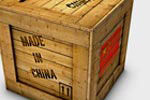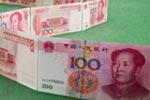China's trade surplus falls by 12.4% in Sept
Updated: 2011-10-13 10:18
(Xinhua)
|
|||||||||||
BEIJING -- China's trade surplus fell for the second straight month in September, dropping by 12.4 percent year-on-year to reach $14.51 billion due to sluggish global demand and rising costs in domestic markets, the General Administration of Customs (GAC) announced Thursday.
September exports rose 17.1 percent year-on-year to reach $169.67 billion. Imports surged 20.9 percent to $155.16 billion, the GAC said on its website.
"The export growth was slower than expected. It will decline to 10 to 15 percent in the future as demand continues to weaken," said Chang Jian, an economist at Barclays Capital.
From January to September, exports and imports amounted to $2.68 trillion, representing a 24.6-percent year-on-year increase. The amount has already exceeded that of the full year of 2008, according to the GAC.
The first nine months of this year saw the trade surplus shrink by 10.6 percent to$107.1 billion.
China's foreign trade structure continued to improve in the first three quarters, with general trade expanding and processing trade dwindling, said Lu Peijun, the GAC's deputy minister.
In the first nine months, general trade accounted for 52.9 percent of the country's total trade, with an increase of 31.7 percent to $1.42 trillion. Processing trade took up 35.9 percent of the total, growing 14.8 percent to $961.6 billion.
The general trade growth rate was 7.1 percentage points higher than that of the same period last year, while processing trade was 3.1 percentage points lower, according to the GAC.
China's dependence on traditional markets, including the European Union (EU), the United States and Japan, has been somewhat alleviated, as trade with emerging countries has grown quickly, Lu said.
In the first nine months, exports to the EU, the United States and Japan accounted for 43.7 percent of the country's total, two percentage points lower compared to a year ago.
Meanwhile, the Association of Southeast Asian Nations (ASEAN) surpassed Japan to become China's third-largest trading partner, with bilateral trade totaling $267 billion, up 26.4 percent.
GAC data showed that export prices of labor-intensive products rose significantly and exports of mechanical and electronic products slowed down due to diminishing demand from the United States and the EU.
Lu Zhengwei, chief financial market economist at the China Industrial Bank, said economic woes in Western countries have had limited impact on China's exports, as the country's main exports are largely restricted to daily necessities.
Lu estimated that the country's exports will grow by 15 to 20 percent next year.
Imports rose strongly, with crude imports up four percent to 190 million metric tons and iron ore imports up 11.1 percent to 510 million metric tons in the first three quarters.
The increased import figures show that the country's policies to boost imports have taken effect, the GAC's Lu Peijun said, adding that China's foreign trade is becoming more balanced with a narrowing surplus but faces increasing uncertainties in the fourth quarter.
"The global economy is slowing down, with protectionism on the rise in developed economies. Yuan appreciation will squeeze further export growth and cause more troubles for small enterprises," Lu said.
China on Wednesday reiterated its firm opposition to a bill passed by the US Senate targeting China's currency policy, saying the move may trigger a trade war and hinder global economic recovery.
However, the deputy minister said he believes that the core competitive advantages of China's manufacturing sector will remain unchanged in the short-term.
"China's foreign trade will rise by about 19 percent and exceed $3.5 trillion for the entire year. The trade surplus will be around $170 billion, slightly lower or equal to that of 2010," he said.
Related Stories
RMB bill threatens trade war 2011-10-11 08:06
Debt crisis may cause more trade friction 2011-09-21 07:51
China does not seek big trade surplus 2011-09-17 11:29
Free trade agreement another boost to business 2011-09-16 08:00
- China's trade surplus falls by 12.4% in Sept
- QDII funds' net worth drops by 17.6% in Q3
- CBRC to enhance liquidity risk management
- Walter tooling up for growth in China
- Sinovel seeking $58m from US supplier
- Stocks rally on talk of gov't support
- Cash-strapped small firms get help
- Taobao Mall changes spark protests













